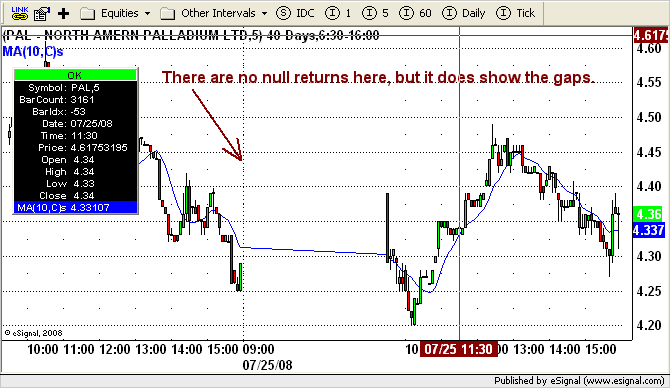PHP Code:
// 10.1.1057
// If an efsInternal series returns some data and then starts to return nuls, the
// plot of an sma of earlier data is offset forwards in time to "eliminate" the gap.
// Plotting the data (rather than the sma()) shows the expected gap.
//
// This situation occurs when processing "sparse" data.
//
// ema() also fails, presumably this is a general "series of a series" bug?
function preMain() {
setCursorLabelName("close()",0);
setDefaultBarFgColor(Color.blue,0);
setCursorLabelName("sma(close(),2)",1);
setDefaultBarFgColor(Color.aqua,1);
setCursorLabelName("close()WithNulls",2);
setDefaultBarFgColor(Color.purple,2);
setCursorLabelName("sma(close()WithNulls",3);
setDefaultBarFgColor(Color.red,3);
}
function main() {
var s1 = efsInternal("closeWithDayofNuls"); // returns close(0), but on previous day returns null
// return (with multipliers to make them visible):
// the close(),
// the sma() of the close(),
// the close() with the day's nulls, and
// the sma() of that series with the nulls
// expect the smas to be in phase with one having a "gap" where price also has a "gap"
// This is best plotted on a fixed day count time template (3 to 5 days).
// See that the sma of the "gap" does not start at the left like all the other lines, as it appears that the gap
// has been joined up and the line aligned to the right.
// So the data to the left of the gap is wrong.
return new Array(close(0), 0.9 * sma(2,close(0)), 0.8 * s1, 0.7 * sma(2,s1));
}
function closeWithDayofNuls() {
var d = new Date();
if (day(0) == (d.getDate() - 1) )
return null; // for previous day return null, so expect to see a gap in the plot for that day
return close(0);
}

Comment